7930446474614d56cf245bdce69a6fd3.ppt
- Количество слайдов: 65

 THIS IS
THIS IS
 With Your Host. . .
With Your Host. . .
 Vocabulary Geography European Exploration 13 Colonies Crisis in the Colonies Revolutionary War 100 100 100 200 102 200 200 300 300 300 400 400 400 500 500 500
Vocabulary Geography European Exploration 13 Colonies Crisis in the Colonies Revolutionary War 100 100 100 200 102 200 200 300 300 300 400 400 400 500 500 500
 What is a handmade object from ancient times? A 100
What is a handmade object from ancient times? A 100
 An artifact A 100
An artifact A 100
 Define culture. A 200
Define culture. A 200
 A way of life. Examples: religion, food, clothing, etc… A 200
A way of life. Examples: religion, food, clothing, etc… A 200
 What is a true account or eyewitness of an event in history? A 300
What is a true account or eyewitness of an event in history? A 300
 A primary source. A 300
A primary source. A 300
 What is a secondary source? A 400
What is a secondary source? A 400
 A second hand account of an event. Someone who was not an eyewitness. A 400
A second hand account of an event. Someone who was not an eyewitness. A 400
 Give 2 examples of primary and secondary sources. A 500
Give 2 examples of primary and secondary sources. A 500
 Primary source: diary, letter, photo Secondary source: textbook, biography A 500
Primary source: diary, letter, photo Secondary source: textbook, biography A 500
 What is a peninsula? B 100
What is a peninsula? B 100
 Land surrounded on three sides by water. B 100
Land surrounded on three sides by water. B 100
 What is the Land Bridge Theory? B 200
What is the Land Bridge Theory? B 200
 A theory that the first Americans crossed a land bridge from Asia to North America by following the migrating animals. B 200
A theory that the first Americans crossed a land bridge from Asia to North America by following the migrating animals. B 200
 Where and when was Jamestown founded? B 300
Where and when was Jamestown founded? B 300
 Virginia in 1607 B 300
Virginia in 1607 B 300
 Explain why the Ohio River Valley is such an important geographic location. B 400
Explain why the Ohio River Valley is such an important geographic location. B 400
 Fertile soil and land near the rivers. B 400
Fertile soil and land near the rivers. B 400
 _ Explain the Native Americans dependency on the environment with the longhouse. B 500
_ Explain the Native Americans dependency on the environment with the longhouse. B 500
 Iroquois used the longhouse because they lived in the eastern woodlands in NY. B 500
Iroquois used the longhouse because they lived in the eastern woodlands in NY. B 500
 What is the Northwest Passage? C 100
What is the Northwest Passage? C 100
 Searching for a direct water route through or around North America. C 100
Searching for a direct water route through or around North America. C 100
 Describe the Columbian Exchange and positive and negative results. C 200
Describe the Columbian Exchange and positive and negative results. C 200
 An exchange of goods, ideas and diseases from Europe to the Americas. Positives of spreading ideas and diversity of goods. Negatives were diseases were spread. C 200
An exchange of goods, ideas and diseases from Europe to the Americas. Positives of spreading ideas and diversity of goods. Negatives were diseases were spread. C 200
 Explain how the Native Americans were affected by the Columbian Exchange. C 300
Explain how the Native Americans were affected by the Columbian Exchange. C 300
 Native Americans died from the European diseases. C 300
Native Americans died from the European diseases. C 300
 Describe the fur trade. C 400
Describe the fur trade. C 400
 French explorers trapping beaver. C 400
French explorers trapping beaver. C 400
 When Europeans came to the Americas which colony became the first English colony? Describe why it was founded and the House of Burgesses. C 500
When Europeans came to the Americas which colony became the first English colony? Describe why it was founded and the House of Burgesses. C 500
 Jamestown. They were coming for money reasons and grew tobacco. House of Burgesses was a representative government. C 500
Jamestown. They were coming for money reasons and grew tobacco. House of Burgesses was a representative government. C 500
 Name the 4 New England Colonies. What was the purpose of the “City on a Hill? ” D 100
Name the 4 New England Colonies. What was the purpose of the “City on a Hill? ” D 100
 New Hampshire, Massachusetts, Connecticut, Rhode Island. City on the Hill- MBC as an example for others to follow (John Winthrop) D 100
New Hampshire, Massachusetts, Connecticut, Rhode Island. City on the Hill- MBC as an example for others to follow (John Winthrop) D 100
 Name the 4 Middle Colonies. What was the nickname? D 200
Name the 4 Middle Colonies. What was the nickname? D 200
 NY, NJ, Delaware, PA Breadbasket colonies D 200
NY, NJ, Delaware, PA Breadbasket colonies D 200
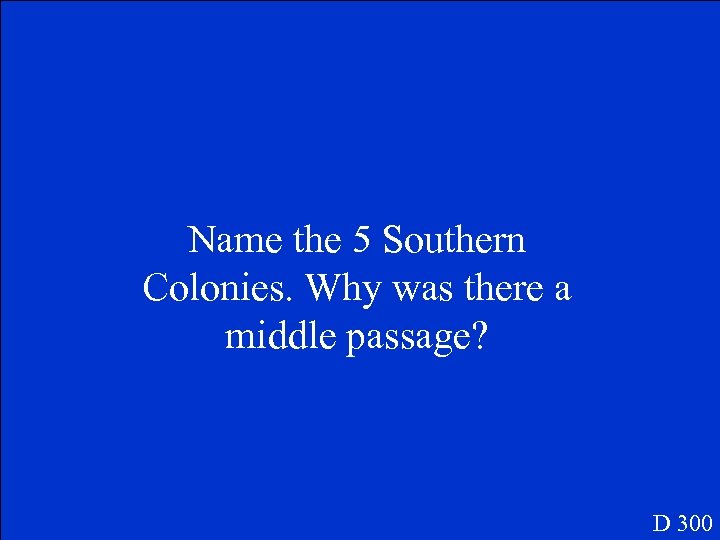 Name the 5 Southern Colonies. Why was there a middle passage? D 300
Name the 5 Southern Colonies. Why was there a middle passage? D 300
 Virginia, S. C. , N. C. , Maryland, Georgia Slaves were needed for their economy. D 300
Virginia, S. C. , N. C. , Maryland, Georgia Slaves were needed for their economy. D 300
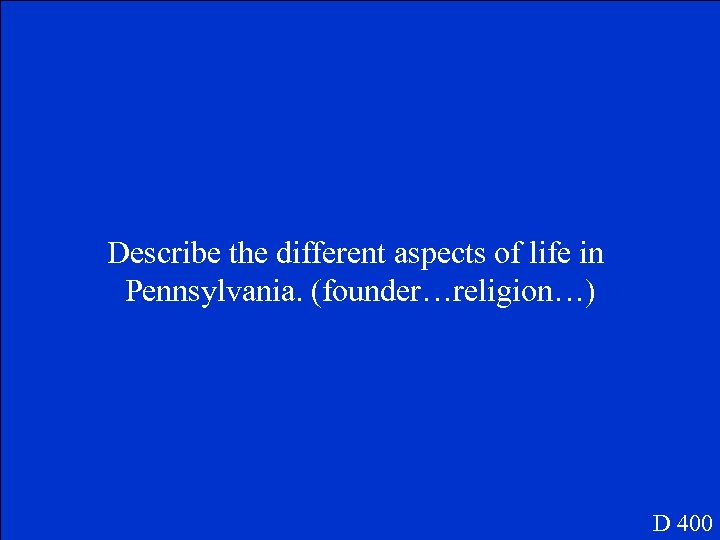 Describe the different aspects of life in Pennsylvania. (founder…religion…) D 400
Describe the different aspects of life in Pennsylvania. (founder…religion…) D 400
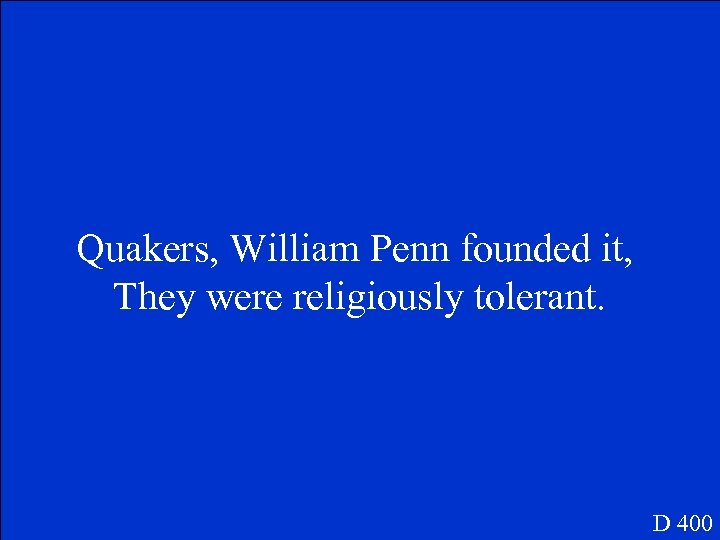 Quakers, William Penn founded it, They were religiously tolerant. D 400
Quakers, William Penn founded it, They were religiously tolerant. D 400
 Describe what happened with New Netherlands in the Middle Colonies. D 500
Describe what happened with New Netherlands in the Middle Colonies. D 500
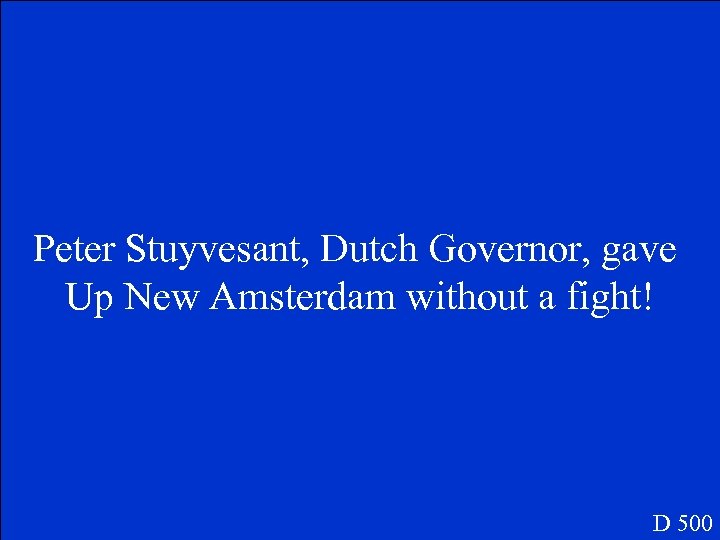 Peter Stuyvesant, Dutch Governor, gave Up New Amsterdam without a fight! D 500
Peter Stuyvesant, Dutch Governor, gave Up New Amsterdam without a fight! D 500
 During the French and Indian War what was the Albany Plan of Union? E 100
During the French and Indian War what was the Albany Plan of Union? E 100
 A plan made by Ben Franklin to encourage the 13 colonies to join as one government. E 100
A plan made by Ben Franklin to encourage the 13 colonies to join as one government. E 100
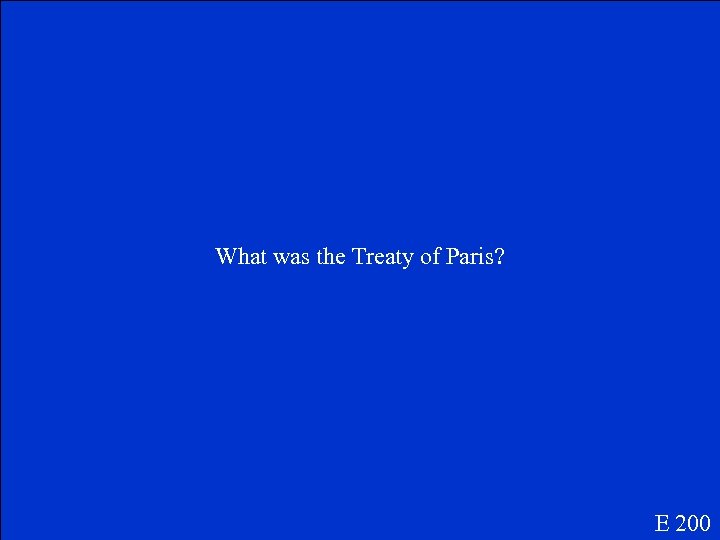 What was the Treaty of Paris? E 200
What was the Treaty of Paris? E 200
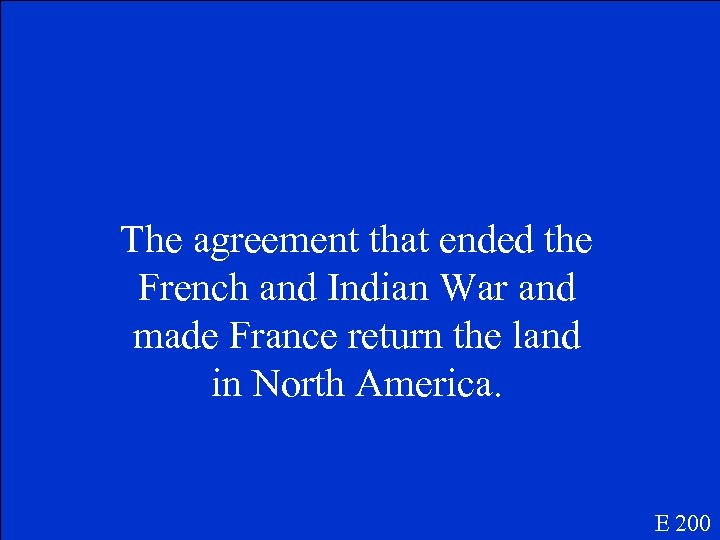 The agreement that ended the French and Indian War and made France return the land in North America. E 200
The agreement that ended the French and Indian War and made France return the land in North America. E 200
 Describe the Stamp Act. E 300
Describe the Stamp Act. E 300
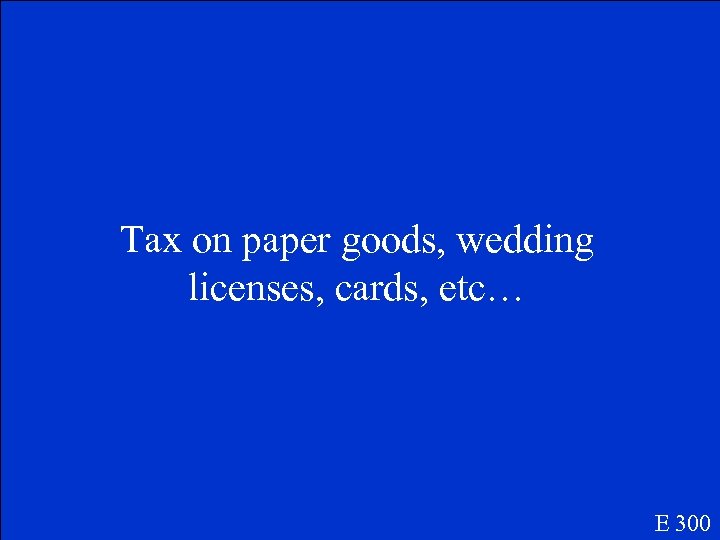 Tax on paper goods, wedding licenses, cards, etc… E 300
Tax on paper goods, wedding licenses, cards, etc… E 300
 • What does “No taxation without representation” mean? E 400
• What does “No taxation without representation” mean? E 400
 American colonists were outraged that they did not have a voice in England’s parliament when they were being taxed. E 400
American colonists were outraged that they did not have a voice in England’s parliament when they were being taxed. E 400
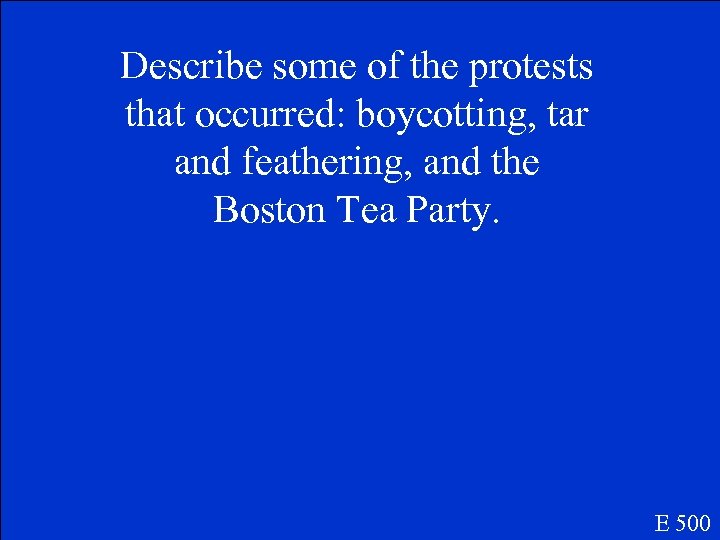 Describe some of the protests that occurred: boycotting, tar and feathering, and the Boston Tea Party. E 500
Describe some of the protests that occurred: boycotting, tar and feathering, and the Boston Tea Party. E 500
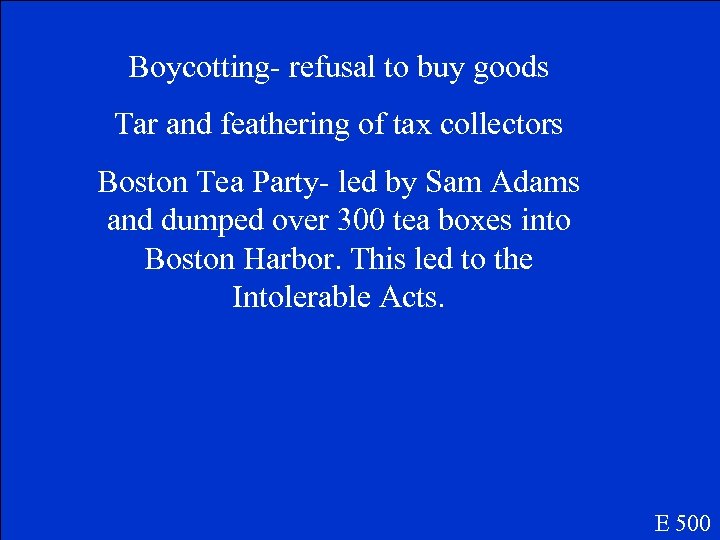 Boycotting- refusal to buy goods Tar and feathering of tax collectors Boston Tea Party- led by Sam Adams and dumped over 300 tea boxes into Boston Harbor. This led to the Intolerable Acts. E 500
Boycotting- refusal to buy goods Tar and feathering of tax collectors Boston Tea Party- led by Sam Adams and dumped over 300 tea boxes into Boston Harbor. This led to the Intolerable Acts. E 500
 Describe a Patriot vs. a Loyalist. F 100
Describe a Patriot vs. a Loyalist. F 100
 Patriots- fight against British rule Loyalist- wanted to be loyal to England fought for British side. F 100
Patriots- fight against British rule Loyalist- wanted to be loyal to England fought for British side. F 100
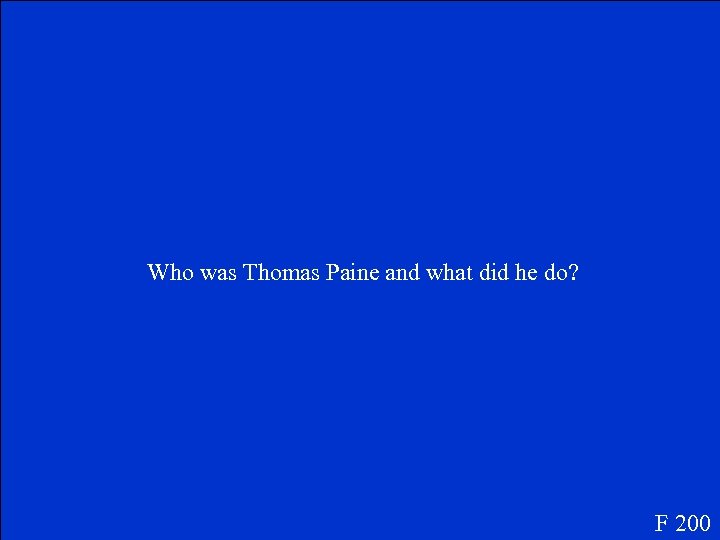 Who was Thomas Paine and what did he do? F 200
Who was Thomas Paine and what did he do? F 200
 He wrote the pamphlet “Common Sense” that said the colonists should break free of England. F 200
He wrote the pamphlet “Common Sense” that said the colonists should break free of England. F 200
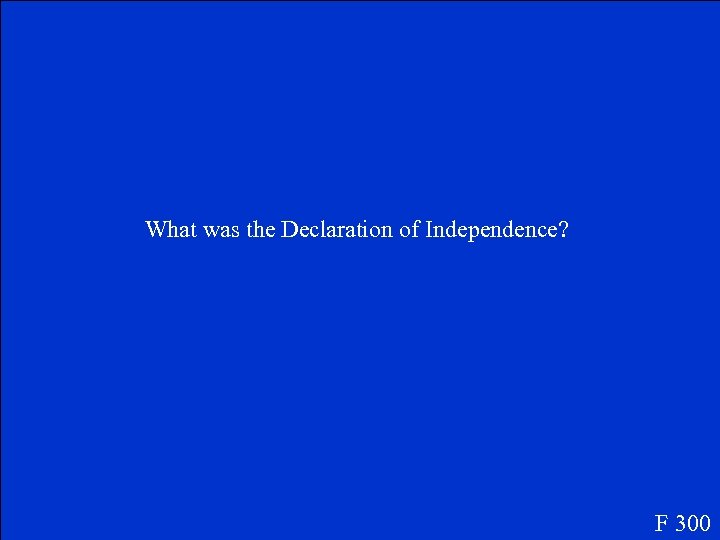 What was the Declaration of Independence? F 300
What was the Declaration of Independence? F 300
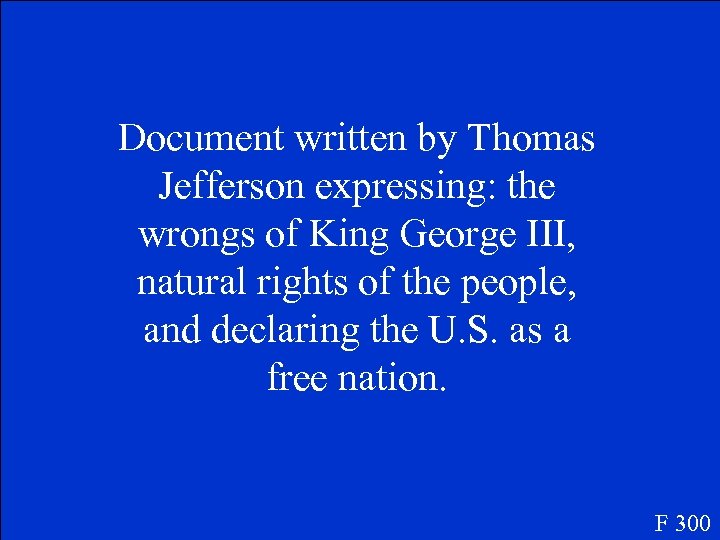 Document written by Thomas Jefferson expressing: the wrongs of King George III, natural rights of the people, and declaring the U. S. as a free nation. F 300
Document written by Thomas Jefferson expressing: the wrongs of King George III, natural rights of the people, and declaring the U. S. as a free nation. F 300
 Describe where the first shots of the Revolutionary War were fired. F 400
Describe where the first shots of the Revolutionary War were fired. F 400
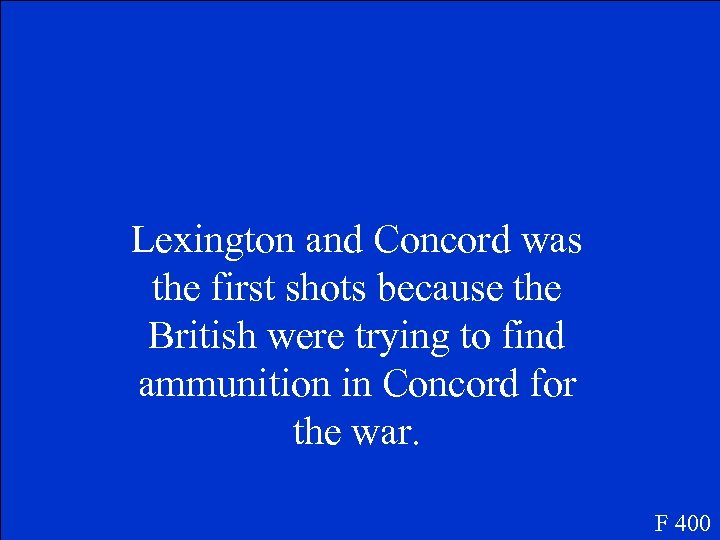 Lexington and Concord was the first shots because the British were trying to find ammunition in Concord for the war. F 400
Lexington and Concord was the first shots because the British were trying to find ammunition in Concord for the war. F 400
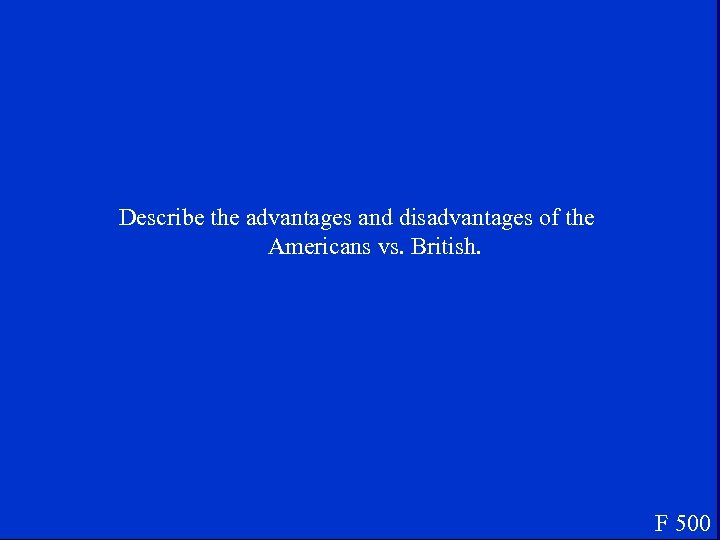 Describe the advantages and disadvantages of the Americans vs. British. F 500
Describe the advantages and disadvantages of the Americans vs. British. F 500
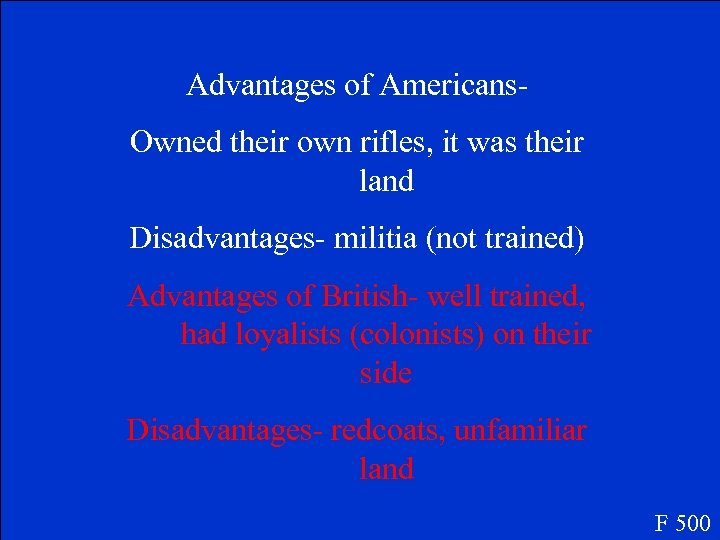 Advantages of Americans. Owned their own rifles, it was their land Disadvantages- militia (not trained) Advantages of British- well trained, had loyalists (colonists) on their side Disadvantages- redcoats, unfamiliar land F 500
Advantages of Americans. Owned their own rifles, it was their land Disadvantages- militia (not trained) Advantages of British- well trained, had loyalists (colonists) on their side Disadvantages- redcoats, unfamiliar land F 500
 Thank You for Playing Jeopardy! Game Designed By C. Harr-MAIT
Thank You for Playing Jeopardy! Game Designed By C. Harr-MAIT
